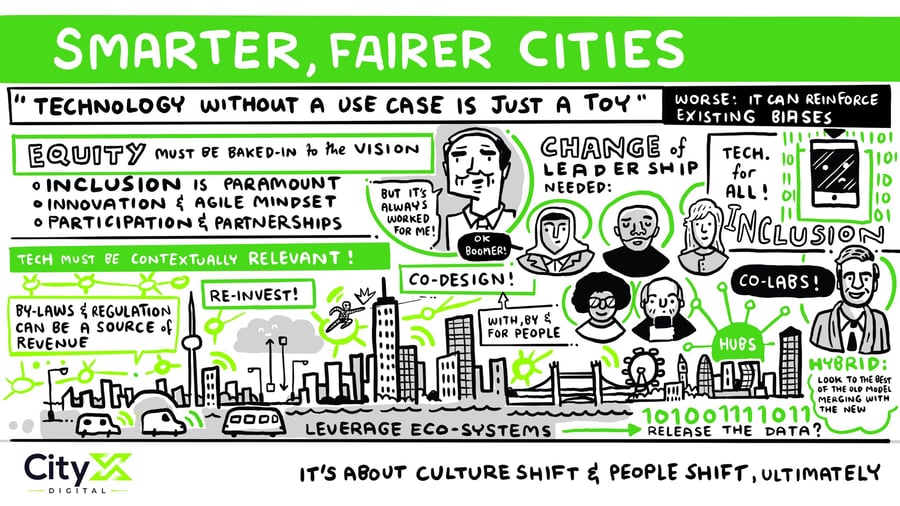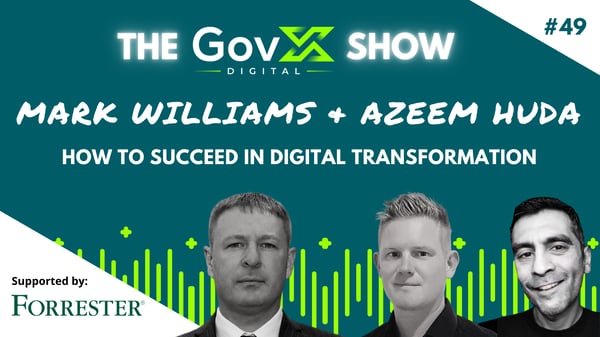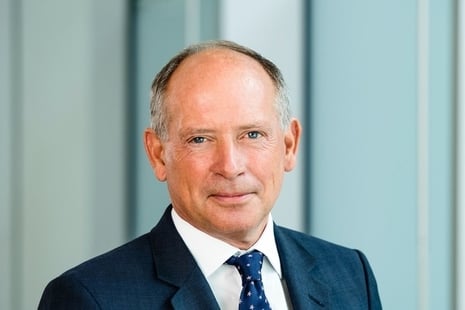How do we create Smarter, Fairer Cities?
Smart Cities integrate technology and data to deliver improved services and environments for their citizens - but what fundamental principles do government leaders need to put in place to make them succeed? At GovX Digital 2020, the panel session ‘Smarter, Fairer Cities’ brought together global leaders to explore the challenges and opportunities of the cities of the future.

Hyper-local collaboration in Smart City Design
 John Paul Farmer, CTO of New York City
John Paul Farmer, CTO of New York City
The pandemic has accelerated the digitisation of society. All the trends that we saw before - telehealth, remote work, people accessing more government services online - have been accelerated to where we thought they might be five or 10 years from now. So the future has been pulled forward. Tech is playing a bigger role in our daily lives than ever before. so we need to embrace this, we need to figure out how we make this experience of using technology better for everybody.
People are at the core of everything. All of this technology is built by people, all the ideas, all the data comes from people. We've realised that nobody knows the needs of a specific neighbourhood better than the folks who live there, work there and experience that specific hyper-local life every single day.
In New York City, we created something called co-labs. It's a neighbourhood-based innovation approach, where we address specifically the communities that are historically under-resourced and too often overlooked. And we codesign with members of the community who often have very little tech experience themselves, but they do have their lived experience. We work with them on the priorities that they see every day.
Then we work to identify where technology or a new approach might make sense. We've done this in Brooklyn on safety at night, we've done this in Manhattan on housing rights and mental health for youth, things that are especially relevant now in the midst of the economic challenges that come along with the pandemic. This neighborhood-based approach allows us to develop contextually relevant technology solutions, so that we don't simply have technology toys, but we have real solutions.
Innovation and community involvement
 Aruj Haider, Chief Digital & Innovation Officer, Westminster City Council
Aruj Haider, Chief Digital & Innovation Officer, Westminster City Council
To create Smart Cities, it cannot be a technology-push agenda, it has to be something we do for the good and betterment of communities. What we’ve seen in the last nine months is how the Covid pandemic adversely affects our communities. On the other hand, we've also seen how technology can help in really simple ways like matching people who are shielding with those who are volunteering, and how much of a positive impact that can play.
So it's about inclusion - how can we make sure that in using technology, we’re accessing the information, opportunities and challenges from all parts of our communities?
The future vision requires innovation - not just sexy, radical technology, but innovation in how we approach and deal with our communities. That mindset is built around experimentation, failing, being okay about that and trying something different. Involving our communities is also experimentation. Typically, city authorities have always done things themselves, based on what they know and the technology that they want to push forward. But taking a step back, involving our communities, being brave, innovative and experimental in our approach is what is going to get us there.
The final things to consider are participation and partnerships. We are not in this alone, we are part of this large ecosystem. How can we leverage our partnerships, both with big technology firms and other cities, but also with SMEs or communities? For me, that's the role of the city - to influence that ecosystem.
Rethinking the value of public sector data
 Miranda Sharp, Mayor of London’s Smart London Board
Miranda Sharp, Mayor of London’s Smart London Board
The challenge is that a Government Minister wants to be seen standing next to an aircraft carrier, not a data catalogue. How do you crack that? The pandemic has given us all a crash course in data. The future has been brought forward and we've had to learn how to interpret data, and ask questions of data.
It’s critical that both municipalities and private enterprises start regarding our data as an asset, otherwise we're not going to manage any radical pivots or change business models. I'm in the UK and am a great user of Citymapper, which is a service that aggregates transport data and enables me to get across London more efficiently. And they do that because Transport For London gives away data to help people make better use of public transport..
But I am appalled, as a citizen, that Citymapper is in a position to sell back data that TfL gave it. The business which Citymapper created was based on TfL giving it data. Transparency and having a cognizant view about what data assets you're giving away, that enable you to expand your reach and do great things as a business, is a wonderful thing. But we've got to be much more grown up about the opportunities and risks presented not only by our own data, but the data that it can be aggregated with.
2020 has given us the opportunity to explore what new work-life models might be. As more of us embrace a hybrid model, that'll have an effect on people's working lives, but also what an urban centre or a high street looks like. People will be less inclined to do long commutes and be more invested in their communities, so how do we use that to leverage places becoming smarter and allowing better outcomes for everyone?
Tackling bias in community transformation
 Alex Benay, Partner at KPMG, & former Government CIO of Canada
Alex Benay, Partner at KPMG, & former Government CIO of Canada
Whether it's something as simple as a website, or as sophisticated as artificial intelligence, we need to make sure that those technologies don't reinforce existing biases or inequities in our communities. When I look at a Smart City, if it isn't accessible for people with disabilities, if it isn't equitable for all, no matter, their race, or religion, or socioeconomic status, then how smart is it? So when we use the term Smart City, baked into that fundamental term needs to be equity and fairness.
To get to a fair city, we're going to need a different kind of leadership. It’s a problem that people in leadership positions grew up creating and supporting the existing environment, so to get fair cities, we have to have hard conversations with people that are in positions that the system worked well for.
The beauty and the scary part of technology is that it's a mirror. If your data is biased when you're automating something, you'll have to tackle that. There’s a tension point between the people that have inadvertently created systems of governance and management of cities, and then the issues that technology is going to generate, because it doesn't care.
The leadership conversation gets to the heart of diversity at the top - most Civil Services promote on the basis of time served. To get the fairest cities, we have to get way more diverse.







